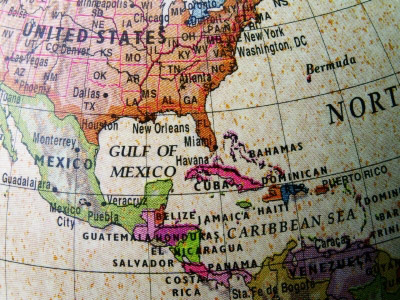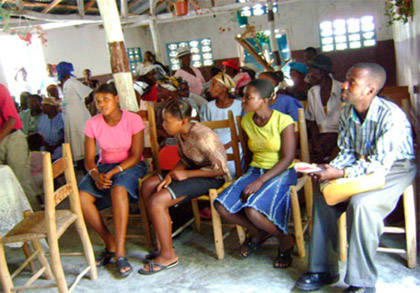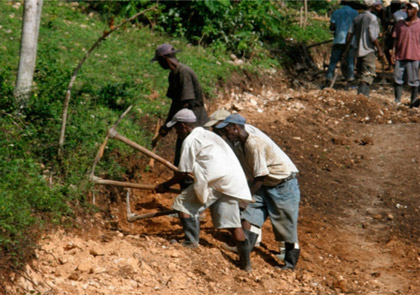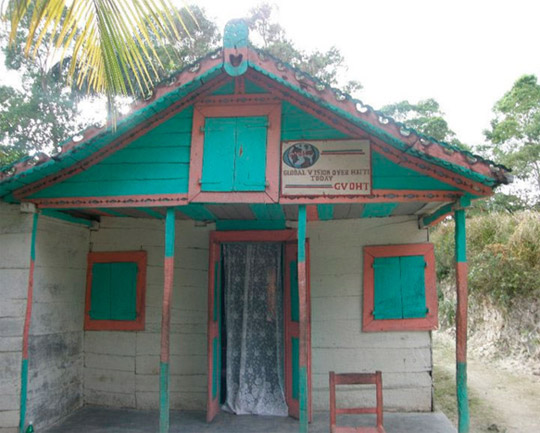Poverty in Morne-A-Bruler: Haiti’s Multi-Dimensional Problems
Until Jan. 12, 2010, few people gave Haiti much thought. However, after the magnitude 7.0 earthquake and global news network coverage of the devastating damage and socio-economic conditions in the aftermath, the country and its people were on the minds of many. For Haitians, though, the new disaster was yet another knockdown for those living in the least developed and poorest country in the Western Hemisphere. Such generational experiences have left a legacy of illiteracy, inadequate or absent healthcare, premature death and extreme poverty. Eighty percent of Haitians live below the poverty line with more than one-half in abject poverty. According to Pranay Udutha from the University of Georgia’s Defense and Diplomacy Center in his 2011 report, Restructuring USAID: A Case Study of Haiti, “This lack of ability to bounce back economically after the disaster has exacerbated the earthquake’s impact and caused the Haitian economy to contract by eight percent. Having little before the disaster means Haitians have little incentive to actively rebuild.”
The World Bank’s 2011 Policy Research Working Paper, Vulnerability and Livelihoods before and after the Haiti Earthquake, states that 55.6 percent of Haitian households live with less than US $1 per day and 76.7 percent with less than US $2 per day. Income is unequally distributed with 20 percent of the poorest receiving 2 percent of total income while 20 percent of the richest receive 68 percent of total income. Haiti is also at the bottom of the World Bank’s rankings of health indicators due to poor sanitation, nutrition and inadequate health services. Almost 50 percent of Haitians have no access to healthcare, 80 percent have no clean drinking water, and 50 percent are classified as “food insecure.” As of 2009, chronic malnutrition (stunting or undersized children) affected from 18.1 to 31.7 percent of 6-month to 5-year old children. Consequently, the under 5-year old mortality rate is twice the regional average, and life expectancy is 18 years shorter than the regional average. Malnutrition is related to food insecurity as food is the main expenditure for Haitian households. As a result, they are defenseless when faced with price fluctuations.
According to the Library of Congress’ Federal Research Division (FRD) 2006 Country Profile on Haiti, life expectancy at birth is only 44 years. The World Health Organization (WHO) estimates that only 43 percent receive the recommended immunizations. Haiti ranks last in the Western Hemisphere for healthcare spending – a mere US $83 annually per person. Only one in four births is attended by a health professional. And, since most rural areas have no access to healthcare, residents are susceptible to otherwise treatable diseases, such as typhoid fever and cholera. Outside Africa, Haiti has the highest incidence of HIV/AIDS in the world. Estimates vary from 4.5 percent nationally to 12 percent in urban areas and 5 percent in rural areas. As of 2006, the number of Haitian babies born infected with AIDS was 5,000. The disease is responsible for one in five infant deaths and 200,000 orphaned children.
Education standards are very low in Haiti as well. According to the FRD 2006 Country Profile on Haiti, the country’s 53 percent literacy rate is far below the 90 percent average for Latin American and Caribbean countries. In 1997 the government created an education plan with the goal of universal access to quality schools.

© iStockphoto.com/zennie
The federal education budget increased from 9 percent in 1997 to 22 percent in 2000 and paid for programs to provide school lunches, uniforms and bus transportation. School attendance rose from 20 percent in 1994 to 64 percent in 2000. According to the FRD Country Profile, “Even with these improvements, however, the country still faces severe shortages in educational supplies and qualified teachers, and the rural population remains vastly underrepresented in the country’s classrooms. Currently, most Haitian schools are private rather than state-funded. International private schools (run by Canada, France or the United States) and church-run schools educate 90 percent of students.”
Morne-A-Bruler & GVOHT
The World Bank contends that poverty in Haiti is all-encompassing and multi-dimensional, and that 70 percent of the 4.5 million destitute live in rural areas. Morne-A-Bruler, a communal section of Haiti, is one such area in serious need of healthcare, education and economic development. Its citizens pray for the same advantages that other mothers and fathers commonly receive for themselves, their children and their community. To this end, Global Vision Over Haiti Today (GVOHT), a Haitian non-profit, humanitarian organization, was started on April 15, 2006, to provide consistent help to local residents. The organization works to provide free education, food and supplies along with creation of shelters and support for the homeless. To succeed, GVOHT is asking for sponsors and investors to help build a community medical center so residents can have ready access to healthcare and medical aids/supplies. GVOHT needs international sponsorship and/or support from any company, agency or voluntary organization willing to assist with this critical mission. Such assistance will make possible a sincere difference in the lives of the people in one of the poorest and most abandoned areas of Haiti.
Morne-A-Bruler peaks at about 800 meters’ altitude and offers beautiful mountain views with deep gorges and green hills. Due to lack of development assistance, residents live in a precarious economic state, cutting trees to make charcoal and practicing rain-fed agriculture. Community expenditures on education, health and food are based on agricultural performance, which is often deficient due to erratic rainfall. Even potable water is non-existent in the area.
Women, who comprise 55 to 60 percent of the area’s total population, have no income. In Haiti, a tendency exists to marginalize women and to trivialize exclusion and violence against them, especially in rural areas. This trend, which is pronounced in families, schools, churches, associations, groups and institutions, has significantly slowed the process of development, progress and community transformation. Women are pillars in decision making, planning and management to local sustainable development.
Only a few people in Morne-A-Bruler have access to healthcare. In case of illness, residents must travel four hours to the nearest city. Fever, filariasis, meningitis and diphtheria are just a few of the diseases affecting residents. One-quarter of area children suffer from malnutrition with noticeable protein and vitamin A deficiencies. Kwashiorkor is prevalent, as is marasmus. Pregnancies and births are complicated, causing eclampsia, sepsis and abortions. Infant mortality is high, especially among the most disadvantaged families. Young, pregnant teenage girls are particularly at-risk as are single family households where only the mother or grandparents care for the children. These children are malnourished because powdered milk is very expensive to buy, and parents do not have adequate resources.

Photo Courtesy of Daniel Joseph
In the aftermath of the Jan. 12, 2012, earthquake, Morne-A-Bruler residents face additional socio-economic and environmental problems with Hurricane Isaac worsening the community situation. Poor families became even poorer with the loss of their agriculture, cattle heads and homes. This, of course, increased the burden on the families’ school budget with immediate consequences for the academic year 2012-2013. A small school is located in the area situated beneath arbors covered with palm leaves. However, when it rains these schools cannot function, and students are forced to stay home until the work space in the classroom dries up. Schools in the department of southeast have no infrastructure and are void of all materials. The teacher to student ratio is one to 100. Such conditions cannot deliver a quality education. Moreover, it is difficult to give homework and to correct exercises, much less regularly assess a pupil’s knowledge. As a result, schools find it difficult to assert their legitimacy. Teachers in these schools receive miserable wages ranging from 750 to 1,000 gourdes ($17.79 to $23.72) per month and are often not regularly paid.
Agriculture & Infrastructure
From an environmental perspective, Morne-A-Bruler differs from other parts of Haiti because it is covered with vegetation, which is quite dense in its valleys, foothills and mountain peaks. However, the majority of the cultivated land is in the foothills and mountains where natural vegetation has been destroyed for the benefit of cereal crops and food. Floods occur after intense rainfall, causing adverse agricultural impacts. Annual losses due to erosion are estimated at several thousand dollars per year. In addition, agriculture is frequently challenged by natural events like storms and cyclones. As a result, charcoal is now a potential income source, reducing soil fertility and agriculture performance due to deforestation. Even now, the situation is almost beyond remediation as no alternative plans nor environmental protection exists.
Agriculture is essential to the economic development of Haiti, yet it faces a variety of constraints. Farming is characterized by the absence of large herds, particularly the Creole Pig whose numbers were significantly reduced from 1980-1983 due to systematic slaughter. It would be possible to reduce these types of losses through regular vaccination campaigns and training. Livestock is particularly important in Morne-A-Bruler and a constant on almost all family farms because it not only provides additional income but also serves as an economic safety net to cover major and/or unforeseen expenses. Cattle are used to produce milk, and litters are used to raise livestock. Horses are the main mode of transport for people and goods. Goats are considered to be mobilized savings, and birds are an excellent source of protein and income for families (eggs, meat).
The road network in Morne-A-Bruler is dirt and impractical for animals, much less humans during the rainy season. Walking and animals are the most common forms of transport. Lack of a transportation infrastructure is a handicap for business, communication and access to potable water.

Photo Courtesy of Daniel Joseph
As a result, people are forced to walk through unsafe gullies and hills to collect unpurified water, which negatively impacts time and health. As a result, families are constantly exposed to water contamination and poor hygiene. In Morne-A-Bruler, sanitation and health services are virtually non-existent as there are no water testing facilities and no means to treat diarrhea and other water-related health problems. Water is life in a community like Morne-A-Bruler. With no purified water to drink, residents are forced to capture their water from untested springs and, sometimes, directly from rivers, gullies and hillsides.
In conclusion, farmers in Morne-A-Bruler practice rain-fed agriculture, which is subject to Nature’s whims and, therefore, highly irregular. Agriculture storage facilities are non-existent, which causes waste after harvest due to no means of storage or processing. In addition, farmers are forced to pay large sums for the purchase of seed markets. Low agriculture productivity is due to the absence of any type of technical supervision. The area has no agricultural extension system, no credit and no training. Solutions to these uncertainties could include establishment of savings and credit programs, agricultural input shops, storage facilities, environmental education, farm training and supervision, and technical education for improving use of pastures and herd/breed maximization. An adequate road system would facilitate transport of goods to market and, possibly, promote development of tourism in what is still a beautiful area of the country.
Morne-A-Bruler is currently characterized by the immigration of families from Port-au-Prince after the 2010 earthquake. The actual rate of unemployment is officially unknown although best estimates cite 80 percent. The community needs basic services and an ability to monitor specific vulnerable groups, such as children, pregnant women and the elderly. A large number of young boys stay in the street because they have no place to go. And, young mothers live in the street with babies crying because they have no place to go either. The latter, in particular, need to learn basic skills so they can be responsible for their future family. GVOHT has inadequate resources to manage these ongoing needs, especially since Morne-A-Bruler is an unknown area far from the main development machine. There is no shortage to the residents’ appeal for help, which is why the area is sending out this emergency call for help to any organization, company or individual who can help.
Morne-A-Bruler is a safe marketplace for development and investment with a ready supply of workers and consumers ready to make and purchase products. Any interested organizations are encouraged to support and to create a working business relationship with GVOHT and its residents so they can share in the available resources. The current vision is to submit projects and work corporately with potential investors, companies or donor agencies so positive change can happen. Haiti is full of social problems, but the solution is to use innovative strategies and projects, joining organizations and people together, to fulfill the promise of Morne-A-Bruler residents so they can accomplish amazing social change while improving their community’s needs.

Photo Courtesy of Daniel Joseph




























